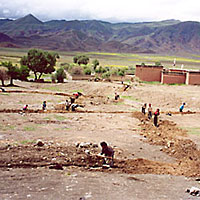
Water Projects in Tibet/China
In Central Tibet there is a dramatic scarcity of rain, concentrated in the short summer months it results in long periods of time when people are completely without water and are forced to drink stagnant waters from naturally forming ponds. This water, often polluted, has grave consequences particularly upon the health of children. There is no water for irrigation, leading to sadly inadequate harvests, and the cultivation of fruit and vegetables is unthinkable resulting in a diet seriously lacking in essential vitamins and minerals. Villages in this area are without aqueducts or sanitation services.
Chilean engineers “Jack Stern Ltd” prepared three projects for this region on behalf of the Lama Gangchen World Peace Foundation – Help in Action. Following the construction of an aqueduct, they estimate to extend the life span of local inhabitants by at least 15 years, thanks to the provision of potable water, improved harvests and the possibility to grow much needed fruit and vegetables.
The first aqueduct to be built, was that of Gangchen Village: it makes use of a natural mountain spring situated some kilometres away from Gangchen and provides enough water to serve three villages, the local school and Clinic. The aqueduct also provides a modest quantity of electrical energy. It was inaugurated with a village party on the 8th of August 2001, in the presence of the district authorities. It has clearly demonstrated in the following years that it is able to withstand the severe weather conditions of the Tibetan winter thanks to the special technology used by the engineers of Jack Stern Ltd.
The second aqueduct was made to serve Namling Village, and a further project for Nye and Dakshu Villages has already been drawn up but is still waiting the necessary finances.
Many other villages have requested help to build aqueducts, water pumps and irrigation systems.
Solar Panels
In the villages of the Gangchen district there is no supply of electricity, the pylons that carry the electrical current to the city stop about 15 kilometres away from the villages. Solar panels are the easiest method to provide energy in these places: those already installed near Gangchen Village provide enough energy to light some rooms of the monastery and clinic. However, electricity is also needed for the village, for the monastery, school and water pump.
